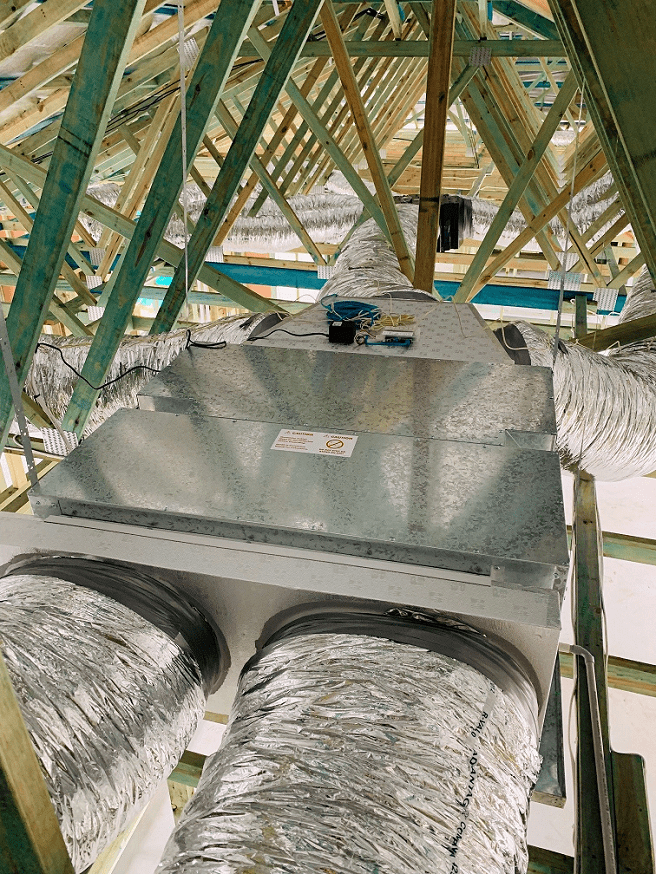Planning to install a ducted air conditioner at your home but aren’t sure what size you need? Before you select a unit for your home, you need to know about the importance of appropriate sizing and how it affects the comfort and energy efficiency of your HVAC system.
Our guide will cover the issues you’ll face due to incorrect sizing and how you can calculate the right size. Calculating the correct duct size for your property depends on how much space you plan to cool at one time, the overall size of your home, and whether the property is properly insulated.
Why You Need To Calculate Duct Size Accurately
Ensuring proper duct sizing for your air conditioner is important for various reasons. The biggest advantage is that your air conditioner will work efficiently, cutting back on energy consumption and reducing electrical bills.
Properly sized ductwork also maintains adequate ventilation and consistent temperature throughout your home. When your ducted air con is the right size, you don’t have to worry about wear and tear, which extends its lifespan.
What Happens If Your Ducted AC Is The Wrong Size
Having an incorrectly sized duct can lead to several issues. Installing an oversized duct can result in poor ventilation and inconsistent temperatures. Meanwhile, an undersized duct can cause more noise, poor efficiency, and reduce the lifespan of the system. And when your system is inefficient because of incorrect sizing, it can contribute to higher bills.
How To Calculate The Correct Size of Your Ducted Air Conditioner
The diameter and size of your duct will determine how much load it can bear. A properly sized duct allows improved airflow and keeps you comfortable while staying energy efficient.
To calculate the sizing for your ducted air conditioner, you need to take into account maximum velocity and the maximum drop in pressure per meter.
Formula For Size Based on Velocity
You can calculate size based on velocity using:
Area = Flow Rate / Maximum Velocity
So if your main ducts are providing a flow rate of 0.029 m³/s at a maximum velocity of 4 m/s, you’ll need an area of 72.5 cm².
So you know that you need an area of 72.5 cm², but how does that affect the size of your circular or rectangular duct?
- For a circular duct, you can find the diameter by multiplying the radius into 2. To find the radius using the area, use the formula r = √(Area / π). Using this formula, your circular duct should have a diameter of at least 9.6 cm.
- For a rectangular duct, you can determine the height by dividing the area from the base. If we assume that the width is 10 cm, the height comes out to 7.25 cm. So, your rectangular duct should be 10 cm x 7.25 cm.
Formula For Size Based on Pressure Drop
Even though you have the right size based on velocity, you need to make sure that it exceeds the maximum pressure per meter.
- If you’re getting a circular duct, start by getting it in the next biggest available duct size. So if you need a diameter of at least 96 mm, you can get a duct with a diameter of 100 mm.
- Because you’re using a 100 mm duct, you’ll need to recalculate the velocity based on the new area. Using the formula, you’ll get a recalculated velocity of 3.69 m/s.
- To calculate the drop in pressure, you need to find the Renolds Number and friction factor using these formulas:
- Reynolds number = Velocity x Diameter x Density / Viscosity
- Friction Factor = 0.11 × {(roughness coefficient/diameter )+ (68/Re)}0.25] × 0.85 + 0.0028
- Lastly, you can calculate the pressure drop and check whether you’re losing more than 1 Pa/m:
Pressure Drop = Friction Factor x (Length/Diameter) x (1/2) x fluid density x Velcoity²
If we continue the example, it shows that the pressure drop would be 2.5 Pm/m with a circular 100 mm circular duct.
In an efficient system, the max pressure drop per meter should be 1 Pa/m. Since the pressure drop is too high with a 100 mm duct, you’ll need to increase the duct size. With a 150 mm duct, you’ll see a pressure drop of 0.33 Pa/m, which is less than 1, making it the right size for your unit.
Calculate Your Home’s Size
Another great way to find out what size of ducted aircon to get is to calculate watts per square method. For this, you’ll need the floor area of your home. To calculate this value, multiply the length and width of each room and add them together. Let’s say that your four bedrooms are 9, 8, 8, and 8 square meters, while the kitchen and dining space is 30 square meters, and the living area is 28 square meters. Altogether, this gives you 91 square meters.
Determine The Heating and Cooling Capacity Needed
When you know how many square meters your home is, you can determine the heating and cooling capacity required by multiplying the value 0.15kW, which is a general rule of thumb recommended for homes in Queensland. So if your home is 91 square meters, you need a unit with a cooling capacity of at least 13.65kW.
So, how much of this space would you like the air conditioner to cool at one time? Few people size their ducted air conditioner to cool their entire home from their kitchen to all their bedrooms.
It’s best to aim for 70 percent, which means cooling at least 70 percent of the home at the same time. To find this, multiple the cooling capacity with 0.7, and you’ll get 9.5kW.
Assess Your Home’s Insulation
Did you know that the size of your cooling system will depend on factors like your ceiling height, number of windows, types of curtains and blinds, and roof ventilation? Not to mention, experts recommend assessing your insulation to keep cool air from escaping, causing a draft. If you suspect that your home’s insulation and ventilation aren’t good enough, we recommend investing in ceiling insulation and roof ventilation to reduce the load on your new ducted air conditioner.
When To Choose A Large Size Ducted Air Conditioner
Experts recommend selecting a large capacity ducted air conditioner if:
- Your home has large windows that face west.
- You have a big family that spends most of its time in living areas and bedrooms during the day.
- Your home isn’t properly insulated
When To Choose A Small Size Ducted Air Conditioning System
In some cases, it’s recommended that you get a ducted air conditioner with a smaller capacity, such as when:
- Your home is properly insulated
- You and your family spend most of your day outside the home
- You have a small family or few occupants living on the property.
- Your home has enough roof space for ventilation
In these cases, a smaller ducted system can get the job done because it’s not exposed to heavy heat load.
Factors To Consider When Sizing Your Ducted Air Conditioner
When you’re selecting a size for your ducted air conditioning system, you need to consider a few factors. For example:
- Does your property get any shade? If so, how many trees are there around your home?
- If your home already has ductwork installed, is it in good condition? We recommend calling in an expert to assess the condition of your existing ductwork.
- How is your home’s insulation and ventilation?
- How many people are in your family and do they spend a lot of time in separate rooms?
- What construction materials is your home made of?
These factors can affect how warm your home gets during the day, how long you need to keep it on every day, and whether your unit will need to work extra hard to keep your home cool.
How Much Does a Ducted Air Conditioner Cost
Unlike split systems, the cost calculation behind ducted systems isn’t the same for everyone. Nevertheless, correctly sized ducted systems are comprehensive solutions for cooling your home. You can expect to pay a higher cost to install a ducted system as opposed to a split system. Besides the upfront cost of the unit itself, you’ll have to consider other expenses. These include installing the ductwork, drainage system, electrical wiring, or even removing the current cooling system.
Consult Our Temper Troops Team For Advice on Duct Aircon Installation
Setting the system design for your home air system is a major investment that’s best left to the professionals. Even if you try doing it yourself, it’s important to remember that several things can go wrong. At Temper Troops, we understand the cooling needs of your home, supply quality aircon units, and can install a system according to your needs. If you’re wondering what size ducting for air conditioning to get, just call us. We can help you select the right unit according to the floor area size of your home.


